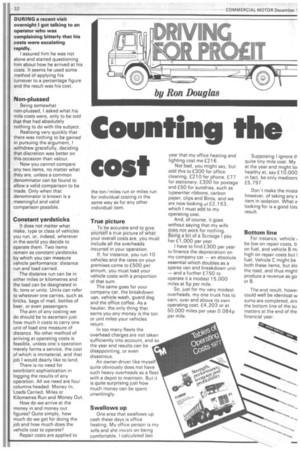Counting the cost
Page 34

If you've noticed an error in this article please click here to report it so we can fix it.
DURING a recent visit overnight I got talking to an operator who was complaining bitterly that his costs were escalating rapidly.
I assured him he was not alone and started questioning him about how he arrived at his costs. It seems he used some method Of applying his turnover to a percentage figure and the result was his cost.
Non-plussed
Being somewhat non-plussed, I asked what his mile costs were, only to be told that that had absolutely nothing to do with the subject.
Realising very quickly that there was nothing to be gained in pursuing the argument, I withdrew gracefully, deciding that discretion was better on this occasion than valour.
Now you cannot compare any two items, no matter what they are, unless a common denominator can be found to allow a valid comparison to be made. Only when that denominator is known is a meaningful and valid comparison possible.
Constant yardsticks
It does not matter what make, type or class of vehicles you run, or, indeed, wherever in the world you decide to operate them. Two items remain as constant yardsticks by which you can measure vehicle performance: distance run and load carried.
The distance run can be in either miles or kilometres and the load can be designated in lb, tons or units. Units can refer to whatever one carries, such as bricks, bags of mail, bottles of beer, or even passengers.
The aim of any costing we do should be to ascertain just how much it costs to carry one unit of load one measure of distance. No other method of arriving at operating costs is feasible, unless one's operation merely forms a service, the cost of which is immaterial,.and that job I would dearly like to land:
There is no need for exorbitant sophistication in logging the results of any operation. All we need are four columns headed: Money In, Loads Carried, Miles or Kilometres Run and Money Out.
How do we arrive at the money in and money out figures? Quite simply, how much do we get for doing the job and how much does the vehicle cost to operate?
Repair costs are applied to the ton/ miles run or miles run for individual costing in the same way as for any other individual item.
True picture
To be accurate and to give yourself a true picture of what your overall costs are, you must include all the overheads incurred in your operation.
If, for instance, you run 10 vehicles and the rates on your premises come to £500 per annum, you must load your vehicle costs with a proportion of that sum.
The same goes for your company car, the breakdown van, vehicle wash, guard dog and the office coffee. As a haulier, the only thing that earns you any money is the ton or unit miles your vehicles return.
In too many fleets the overhead charges are not taken sufficiently into account, and so the year end results can be disappointing, or even disastrous.
An owner-driver like myself quite obviously does not have such heavy overheads as a fleet with a depot to maintain. But it is quite surprising just how much money can be spent unwittingly.
Swallows up
One area that swallows up cash these days is office heating. My office person is my wife and she insists on being comfortable. I calculated last year that my office heating and lighting cost me £216.
Not bad, you might say, but add this to £300 for office cleaning, £210 for phone, £77 for stationery, £300 for postage and £50 for sundries, such as typewriter ribbons, carbon paper, clips and Biros, and we are now looking it £2,153, which I must add to my operating cost.
And, of course, it goes without saying that my wife does not work for nothing. Being a bit of a Scrooge I pay her £1,000 per year.
I have to find E300 per year to finance the depreciation on my company car — an absolute essential which doubles as a spares van and breakdown unit — and a further £750 to operate it a modest 15,000 miles at 5p per mile.
So, just for my very modest overheads, my one truck has to earn, over and above its own operating cost, £4,203 or at 50,000 miles per year 0.084p per mile.
Supposing I ignore tlquite tiny mile cost. My at the year end might lo( healthy at, say £10,000 in fact, be only mediocre £5,797.
Don't make the mista however, of taking any s item in isolation. What v looking for is a good tote result.
Bottom line
For instance, vehicle be low on repair costs, b on fuel, and vehicle B mi high on repair costs but I fuel. Vehicle C might be both these items, but slo the road, and thus might produce a revenue as go or B.
The end result, howe‘ could well be identical w sums are completed, an( the bottom line of the su matters at the end of the financial year.




























































































